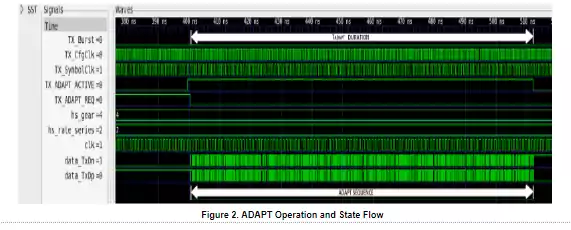
loading...

Introduction
In today's world, MIPI MPHY became a popular specification for mobile devices as it supports multiple applications with high data bandwidth and low power consumption. MIPI MPHY-4.1 VIP provides high speed data rate of upto 11.6Gbps as it has been introduced with a high speed gear HS_G4 over existing gears HS_G3 in MPHY 4.0. But data transfer at such high speed rate can lead to Inter-Symbol-Interference (ISI). To overcome ISI and prevent loss of data at high speed data rate of about 11.6Gbps, MPHY 4.1 is introduced with an ADAPT feature.
Equalizers and need for training sequence
Nullifying the ISI effect requires an additional circuitry like equalizer at the receiver end, so that correct high speed data can be sampled. Equalizer matches the impedance of transmission lines to reduce the inter-symbol interference. Most common equalizer used in digital communication is the adaptive equalizer.
.webp)
Equalizers require a known data sequence to be transmitted for the initial training period. Such initial training sequence are transmitted over all the available transmission lines. Equalizer then matches the impedance of transmission lines to reduce the inter-symbol interference and eventually minimizes the BER (Bit-Error-Rate).
Adapt Training Sequence in MPHY 4.1
The MPHYv4.1 uses adapt sequence to train it’s RX-Equalizer. The adapt sequence supports both Initial and Refresh training modes. The ADAPT sequence is an optional feature of MIPI MPHY 4.1 and is not mandatory to perform before initiating high speed burst with HS_G4. So, before receiving data stream in HS_G4 gear, M-PHY receiver with equalizer may receive adapt training sequences for a period of ADAPT length i.e. TADAPT to adapt its filter characteristics to the channel.
Generating Adapt Sequence in MIPI MPHY 4.1
Any MPHY TX shall follow the following steps to generate ADAPT sequence:
The ADAPT’ pattern consists of 650 bits which include Marker0 + PRBS9 pattern + 1’b0.
The same ADAPT pattern shall be generated throughout all the data lanes. MPHY TX shall generate the ADAPT pattern only when the higher layer application protocol request MPHY TX to generate.
The ADAPT duration of M-TX i.e. TADAPT according to the remote M-RX capabilities RX_HS_ADAPT_INITIAL_Capability and RX_HS_ADAPT_REFRESH_Capability.
RX_HS_ADAPT_INITIAL_Capability describe the length for an initial ADAPT after power-up,
RX_HS_ADAPT_REFRESH_Capability describe the length for a shorter refresh ADAPT sequence during LINK operation.
The figure below shows the waveform for the ADAPT operation of MPHY Data Lane operating at HS-G4.gear:

Conclusion
Emerging technologies like 5G mobile platforms, connected/autonomous/semi-autonomous vehicles, Internet of Things (IoT) devices , AR and VR demands high Data transmission rates with minimum latency.When the data is processed at such high speeds, the medium becomes susceptible to ISI and data loses. To mitigate these effects, adaptive equalizers are being used extensively, which have now grown to become invaluable system component in modern industry. MPHY's receiver uses ADAPT pattern in HS_G4 speed to perform equalization so that data at high speeds (max value of 11.6 Gbps) can be sampled correctly.